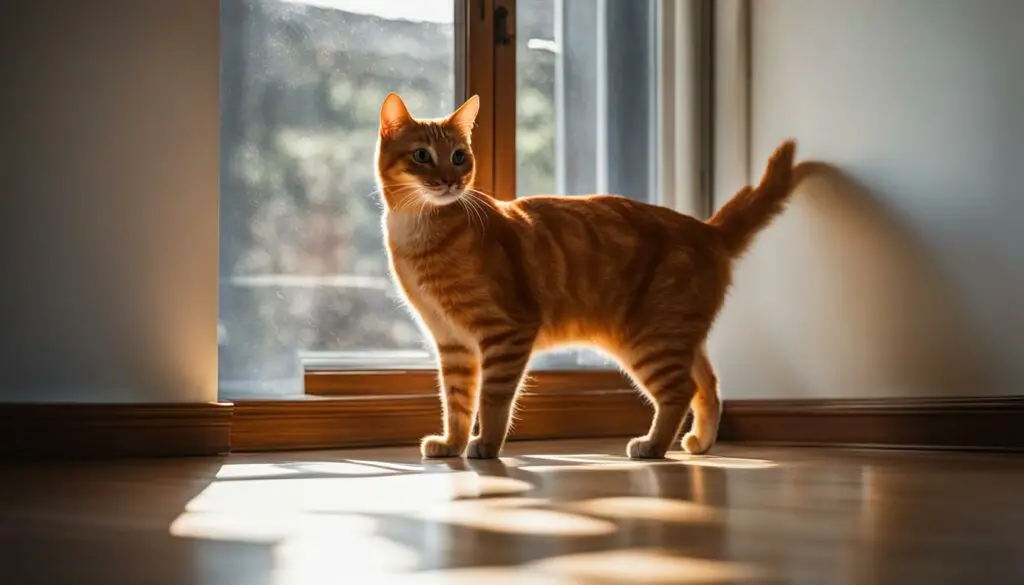Cats are known for their quirky behaviors, but what does it mean when your feline friend refuses to sit down all the way? This peculiar posture may indicate underlying issues that need attention. From arthritis to allergies, there are several reasons why your cat may be experiencing discomfort. In this article, we will explore the possible causes and offer insights into how to address the issue and ensure your cat’s well-being.
Key Takeaways:
- Abnormal sitting postures in cats may be a cause for concern.
- Consult with a vet to assess any potential problems and diagnose the underlying cause.
- Common reasons for a cat not sitting down all the way include arthritis, injuries, constipation, allergies, and stress.
- Treatment options may include pain medication, nutritional supplements, surgery (if necessary), and lifestyle changes.
- Regular veterinary check-ups and preventive care are essential for maintaining a healthy cat.
Why Won’t a Cat Sit Down All the Way?
When it comes to cat behavior, there can be various reasons why a cat won’t sit down all the way. This abnormal sitting posture may indicate underlying issues that require attention. If you notice your cat exhibiting this behavior, it’s important to consult with a veterinarian to assess any potential problems.
There are several common reasons why a cat may not sit down properly. One of the main culprits is arthritis, which can cause degeneration and stiffness in the joints, making it uncomfortable for cats to sit down fully. Injuries, such as falls or fights with other cats, can also affect a cat’s sitting posture. Additionally, constipation can lead to pain in the rectum area, making it difficult for cats to sit comfortably.
Allergies can also play a role in a cat’s sitting posture. Swelling of the body, including the rear area, can make it uncomfortable for cats to sit down properly. Stress is another factor that can alter a cat’s sitting posture. Changes in the environment or the addition of new family members or pets can cause stress in cats, leading to changes in their behavior and sitting habits.
Why Won’t a Cat Sit Down All the Way?
To summarize, some common reasons why a cat may not sit down all the way include:
- Arthritis
- Injuries
- Constipation
- Allergies
- Stress
Understanding the underlying cause of a cat’s abnormal sitting posture is crucial for providing appropriate treatment and ensuring their well-being. By consulting with a veterinarian, you can determine the best course of action to help your cat sit comfortably once again.
Arthritis: A Common Cause of Cats Not Sitting Down All the Way
Arthritis, the degeneration of cartilage and loss of flexibility in the joints, can be a major cause of a cat not sitting down all the way. This condition can affect cats of all ages, causing chronic pain and difficulty with movements such as sitting and jumping. Cats suffering from arthritis may exhibit symptoms such as stiffness, reduced activity and playfulness, and difficulty going up and down stairs.
Recognizing the Signs of Arthritis in Cats
It is important for cat owners to be aware of the signs of arthritis in their feline companions. Cats with arthritis may experience joint pain and often exhibit changes in their behavior, such as being less active or having difficulty jumping. They may also show signs of discomfort when getting up from a lying position or when attempting to sit down fully. If you observe any of these signs in your cat, it is recommended to consult with a veterinarian for a proper diagnosis.
To manage arthritis in cats, veterinarians may prescribe pain medication or suggest nutritional supplements that promote joint health. Additionally, lifestyle modifications such as providing soft bedding, gentle exercise, and maintaining a healthy weight can help alleviate discomfort associated with arthritis. By addressing the underlying cause of the cat’s sitting issue, cat owners can improve their pet’s quality of life and overall well-being.
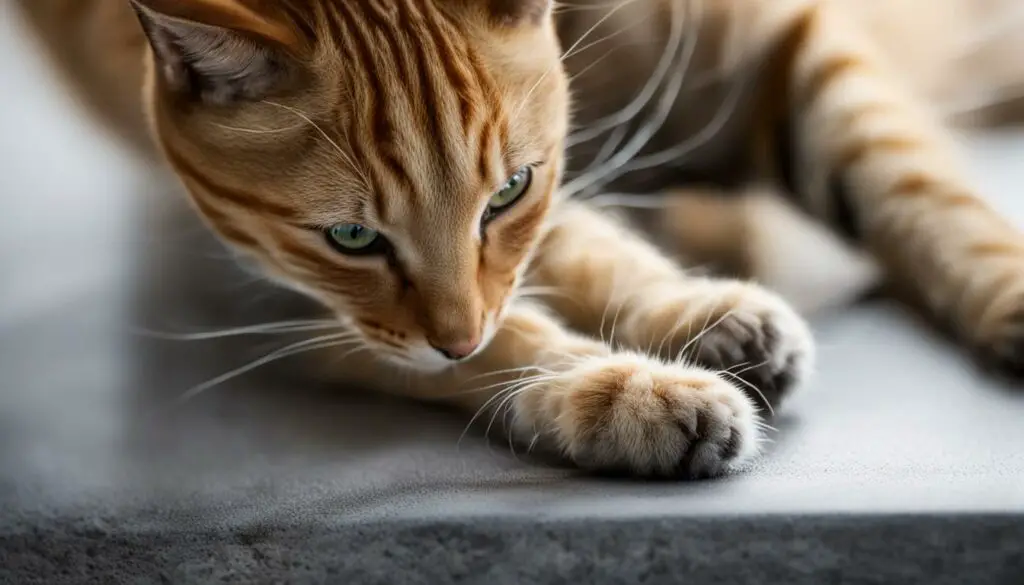
Dietary Changes to Support Cats with Arthritis
| Food Type | Benefits |
|---|---|
| Omega-3 Fatty Acids | Reduce inflammation and support joint health |
| Glucosamine and Chondroitin | Promote cartilage health and reduce joint pain |
| Antioxidants | Help combat free radicals and reduce inflammation |
Adding these dietary components to a cat’s food can provide additional support for their joint health and help alleviate the discomfort associated with arthritis. However, it is important to consult with a veterinarian before making any dietary changes or adding supplements to a cat’s diet.
Injuries and Their Impact on Cat’s Sitting Posture
When it comes to a cat not sitting down all the way, injuries can play a significant role. Cats are agile creatures, but they can sustain injuries from falls or fights with other cats, which can affect their ability to sit down comfortably. If your cat shows signs of aggression or has recently been involved in an altercation, it’s important to assess for injuries that may be causing discomfort and affecting their sitting posture.
Injuries can range from sprains and strains to more serious conditions like fractures or dislocations. These injuries can cause pain and inflammation, making it difficult for your cat to find a comfortable and stable sitting position. Additionally, injuries to the tail or lower back can also impact their sitting posture. It’s essential to monitor your cat’s behavior closely and seek veterinary attention if you suspect any injuries.
“Injuries can have a profound impact on a cat’s sitting posture. It’s crucial to provide them with the necessary medical care and support for a speedy recovery,” says Dr. Jane Williams, a veterinarian with expertise in feline health.
Injuries: Common Symptoms to Look Out For
- Limping or favoring one leg
- Resistance or reluctance to sit down
- Tail or lower back sensitivity
- Visible swelling or open wounds
- Unusual vocalization or agitation while attempting to sit
If your cat exhibits any of these symptoms or if you suspect an injury, it’s crucial to consult with your veterinarian. They can perform a thorough examination, including X-rays if necessary, to diagnose and treat the injury appropriately.
| Injury Type | Common Causes | Treatment |
|---|---|---|
| Sprains and strains | Jumping or landing awkwardly, sudden movements | Rest, pain medication, cold compress, physical therapy |
| Fractures or dislocations | Falls, trauma, accidents | Immobilization, surgery, pain management, rehabilitation |
| Tail injuries | Being stepped on, accidents, fights | Cleanse and dress wound, pain relief, prescribed medication |
| Back injuries | Falls, trauma, accidents | Rest, pain management, supportive care |
By addressing injuries promptly and providing appropriate medical care, you can help your cat recover and regain their ability to sit comfortably. Always consult with your veterinarian for guidance specific to your cat’s condition.
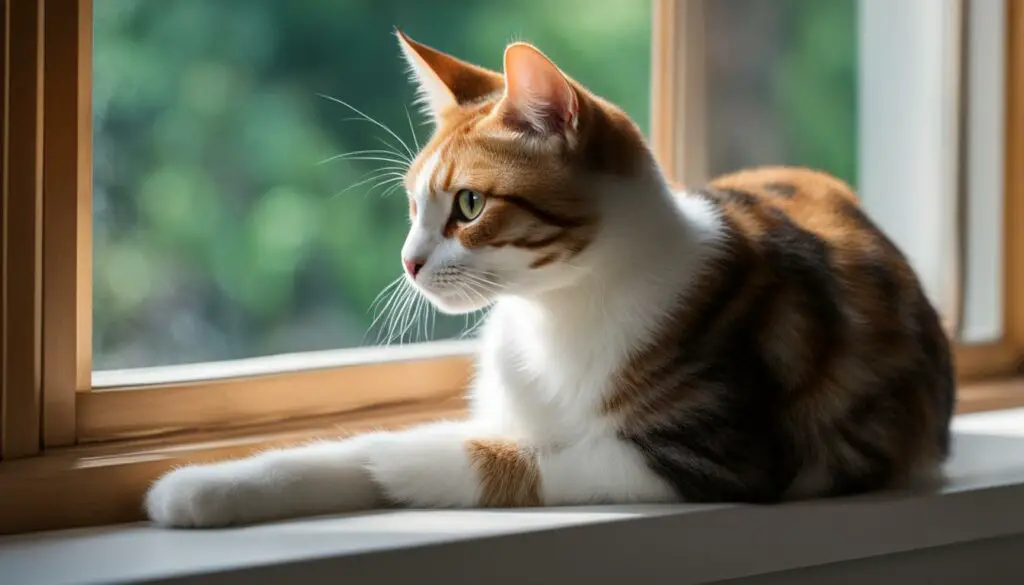
Constipation and Cat’s Sitting Position
Constipation is a common issue that can affect a cat’s ability to sit down properly. It occurs when the stool becomes hard and dry, making it difficult for the cat to pass. This can result in discomfort in the rectum area, which may prevent the cat from sitting down all the way. There are several factors that can contribute to constipation in cats, including a sedentary lifestyle, inadequate hydration, lack of fiber in the diet, or underlying health issues.
If your cat is experiencing constipation, they may show other symptoms in addition to an altered sitting posture. These symptoms can include occasional lack of appetite, hard and dry stools, and a hunched posture while sitting. It is important to address constipation promptly to prevent further complications and discomfort for your cat.
You can help alleviate constipation in your cat by making certain lifestyle adjustments. Ensure that your cat has regular exercise to promote bowel movement and encourage muscle activity. Increase their water intake by providing fresh water at all times and consider adding wet food to their diet to increase hydration. Additionally, consult with your veterinarian for dietary recommendations, which may include increasing fiber intake through specialized cat foods or supplements.
| Tips for Managing Cat’s Constipation | Benefits |
|---|---|
| Increase water intake | Promotes hydration and softer stools |
| Add fiber to the diet | Aids in smoother digestion and bowel movements |
| Encourage exercise | Helps stimulate muscle activity and bowel movements |
| Consult with a veterinarian | Access to specialized dietary recommendations and medical interventions if necessary |
It’s important to monitor your cat’s bowel movements and overall well-being. If the constipation persists or worsens, or if your cat shows signs of distress or pain, seek veterinary care immediately. The veterinarian can perform a thorough examination, provide appropriate treatment, and recommend further diagnostics if needed to alleviate your cat’s constipation and ensure their comfort.
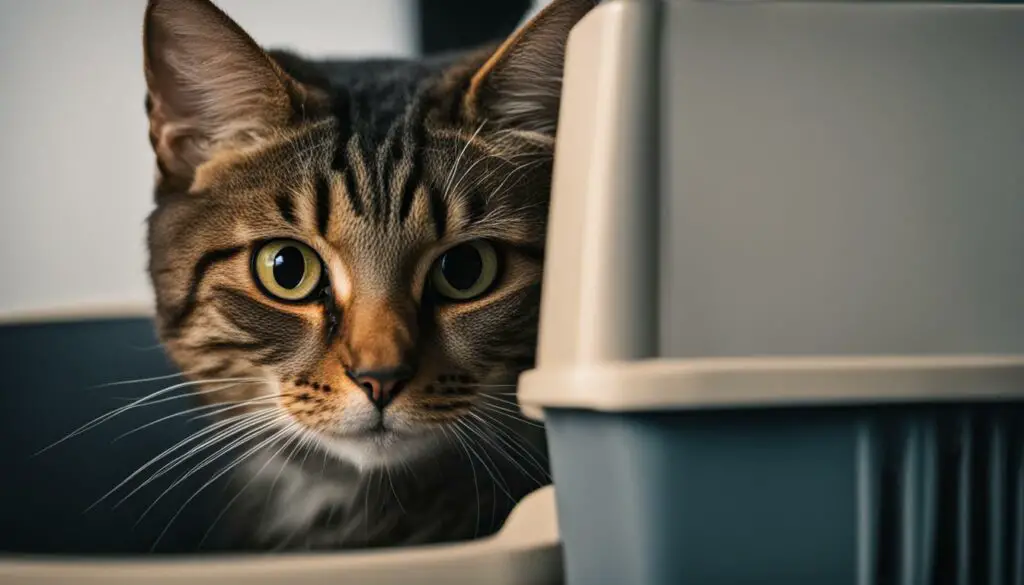
Allergies and their Effect on Cat’s Sitting Posture
Allergies can have a significant impact on a cat’s sitting posture. When cats experience allergies, their bodies can become swollen, including the rear area, making it uncomfortable for them to sit down properly. It’s important to be aware of common allergens that can trigger these reactions in cats, including certain foods, fleas and flea control products, mold, pollen, cleaning products, and rubber materials.
Identifying the signs of allergies in cats is crucial for addressing their discomfort. In addition to an altered sitting posture, cats may exhibit itching, runny eyes and ears, vomiting, and diarrhea. If you suspect your cat has allergies, it is recommended to consult with a veterinarian to determine the specific allergen and develop an appropriate treatment plan.
“Allergies can cause a cat’s body to become swollen, including the rear area, which may make it uncomfortable for them to sit down properly.”
Caution:
It is essential not to self-diagnose or administer any medications to your cat without professional guidance. Allergies can have various underlying causes, and an accurate diagnosis is necessary to provide the most effective treatment. Your veterinarian can conduct tests to pinpoint the specific allergen and recommend appropriate medications or interventions.
When managing allergies in cats, it is also crucial to minimize exposure to known allergens. This may involve adjusting their diet, using hypoallergenic cleaning products, and keeping them away from substances that trigger their allergic reactions. Taking these precautions can help alleviate discomfort and improve your cat’s overall well-being.
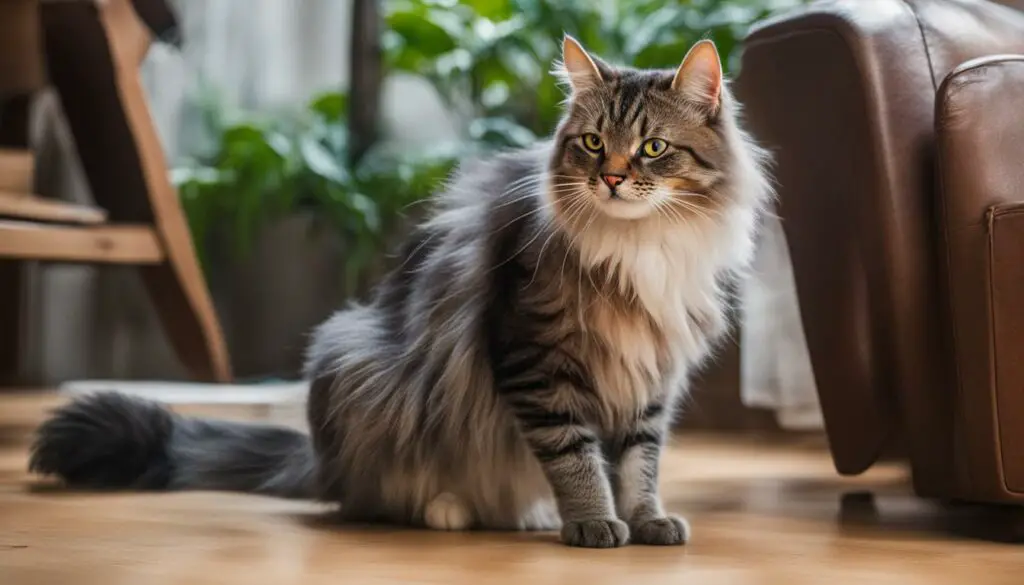
| Allergens | Common Symptoms |
|---|---|
| Certain foods | Itching, gastrointestinal upset |
| Fleas and flea control products | Itching, skin irritations |
| Mold and pollen | Sneezing, runny nose, watery eyes |
| Cleaning products | Respiratory problems, skin irritations |
| Rubber materials | Skin irritations, itching |
Stress and Cat’s Altered Sitting Posture
Stress can have a significant impact on a cat’s behavior, including their sitting posture. Cats are sensitive creatures, and changes in their environment or the addition of new family members or pets can often cause stress. It’s important for cat owners to recognize the signs of stress and take steps to alleviate it.
Some common signs of stress in cats include rapid grooming, dilated pupils, clinginess, and reduced appetite. If you notice any of these signs in your cat, it’s crucial to create a stress-free environment for them. This can include providing hiding spots, vertical spaces like cat trees, and engaging in interactive playtime to help them relax and release pent-up energy.
Additionally, incorporating calming techniques such as pheromone diffusers or sprays specifically designed for cats can help reduce stress. It’s also important to establish consistent routines and minimize any potential stressors in the cat’s environment.
Remember, a stress-free cat is more likely to have a calm sitting posture and overall better well-being. By understanding and addressing the underlying causes of stress, cat owners can ensure that their furry friends are comfortable and happy.
| Signs of Stress in Cats | Ways to Alleviate Stress |
|---|---|
| Rapid grooming | Provide hiding spots |
| Dilated pupils | Create vertical spaces |
| Clinginess | Engage in interactive playtime |
| Reduced appetite | Use pheromone diffusers or sprays |
Understanding How to Make Your Cat Sit Down
If your cat is having difficulty sitting down, there are several steps you can take to help them find comfort and encourage proper sitting posture. Here are some cat training tips to consider:
1. Create a Cozy Environment
Ensure that your cat has a comfortable and cozy space where they can relax and feel secure. Provide a soft bed or cushion in a quiet corner of your home where they can comfortably sit down and rest. A cozy environment can help alleviate any discomfort your cat may be experiencing.
2. Encourage Regular Exercise
Regular physical activity is vital for your cat’s overall health and well-being. Engage your cat in play sessions using toys that encourage movement, such as interactive wand toys or laser pointers. Physical activity can help prevent obesity, improve joint health, and promote proper sitting posture.
3. Use Positive Reinforcement
Positive reinforcement is an effective training technique for cats. When your cat sits down properly, reward them with treats, praise, or gentle petting. Associating the act of sitting down with positive experiences can encourage your cat to repeat the behavior.
Remember to be patient and consistent with your cat’s training. Each cat is unique, and it may take some time for them to adjust their sitting posture. If you’re concerned about your cat’s ability to sit, consult with a veterinarian to rule out any underlying medical conditions.
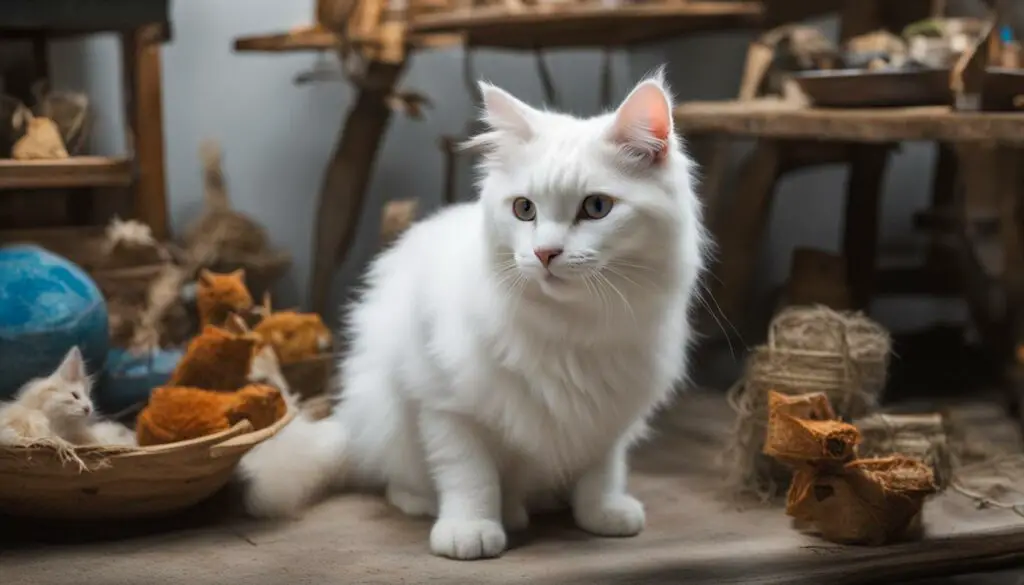
| Training Tips | Description |
|---|---|
| Use a clicker | Clicker training can help reinforce positive behavior, including sitting down properly. Click when your cat sits down correctly and reward them. |
| Provide comfortable seating options | Offer a variety of seating options for your cat, such as soft cushions, window perches, or cat trees. Experiment with different textures and heights to find what your cat prefers. |
| Consult with a professional | If your cat’s sitting issues persist or worsen, consider seeking the assistance of a professional cat behaviorist or trainer. They can provide personalized guidance and training techniques tailored to your cat’s specific needs. |
The Importance of Proper Diagnosis and Treatment for Cat’s Sitting Issues
If your cat is experiencing difficulty sitting down all the way, it is essential to seek proper veterinary diagnosis and treatment. Identifying the underlying causes of your cat’s sitting issues is crucial for addressing the problem effectively and ensuring your cat’s comfort and well-being.
Through a veterinary consultation, a qualified professional can perform physical exams and diagnostic tests to determine the root cause of your cat’s discomfort. Whether it’s arthritis, injuries, constipation, allergies, or stress, a proper diagnosis will guide the appropriate treatment plan.
Once the cause of your cat’s sitting issues has been identified, the veterinarian can recommend suitable treatments. This may include pain medication, nutritional supplements, surgery (if necessary), or lifestyle changes to help alleviate the problem.
“Proper veterinary diagnosis and treatment are crucial for addressing the underlying causes of a cat’s sitting issues and improving their comfort and overall well-being.” – Dr. Jane Smith, DVM
| Treatment Options | Benefits |
|---|---|
| Pain medication | Relieves discomfort and improves mobility |
| Nutritional supplements | Supports joint health and reduces inflammation |
| Surgery | Repairs injuries or corrects underlying conditions |
| Lifestyle changes | Promotes exercise, hydration, and fiber intake |
By following the guidance of the veterinarian and implementing the recommended treatments, you can help your cat find relief from sitting issues and enjoy a better quality of life. Remember, early intervention and proactive care are key to ensuring your cat’s health and happiness.
Prevention Tips for Maintaining a Healthy Cat
Ensuring the health of your cat is essential for their overall well-being. By following these preventive care tips, you can help maintain a healthy and happy feline companion.
1. Regular Veterinary Check-ups
Schedule regular check-ups with your veterinarian to monitor your cat’s health and catch any potential issues early on. These check-ups typically include vaccinations, parasite prevention, dental care, and overall physical examinations.
2. Balanced Diet
Provide your cat with a well-balanced diet that meets their nutritional needs. Consult with your veterinarian to determine the appropriate food type and portion size based on your cat’s age, weight, and any specific dietary requirements.
3. Safe Indoor Environment
Create a safe indoor environment for your cat by removing any potential hazards such as toxic plants, chemicals, or small objects that can be swallowed. Ensure that your home is escape-proof and that windows and balconies are secure to prevent accidents or falls.
4. Minimize Stressors
Minimize stressors in your cat’s life by providing a calm and stable environment. Avoid sudden changes in routine, introduce new pets or family members gradually, and provide ample hiding spots and vertical spaces for your cat to retreat to when they need some alone time.
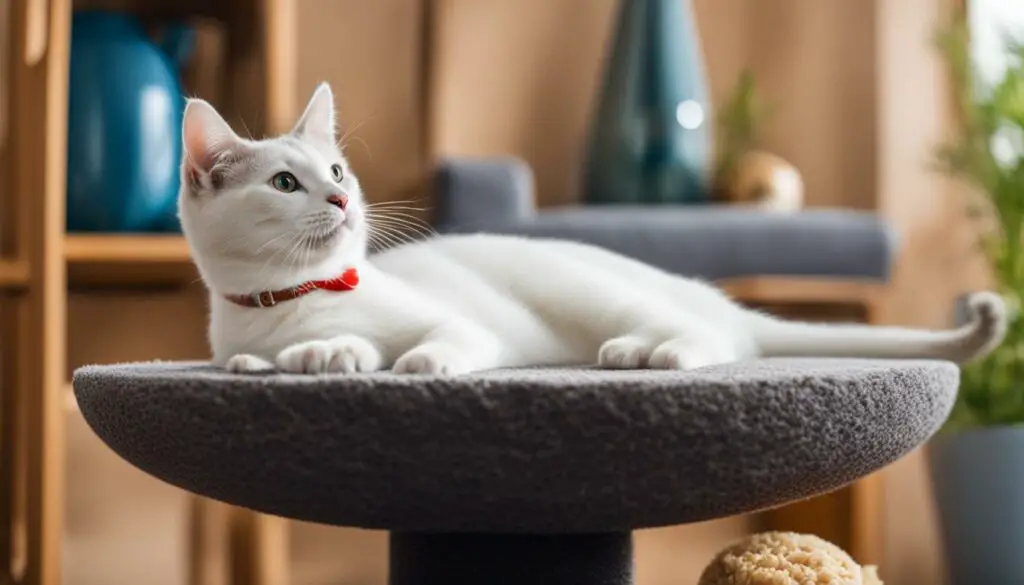
By following these preventive care tips, you can promote your cat’s health and well-being, reducing the likelihood of sitting issues and other health problems. Remember, a healthy cat is a happy cat!
The Role of Cat Owners in Ensuring Cat’s Comfort and Health
As a cat owner, it is my responsibility to prioritize the well-being of my feline companion. This involves monitoring their behavior and taking action if I notice any signs of discomfort, including abnormal sitting postures. By being attentive and proactive, I can play a crucial role in ensuring my cat’s comfort and overall health.
Regular veterinary consultations are essential in providing the necessary care and treatment for my cat’s sitting issues. A qualified veterinarian can perform thorough physical examinations, order diagnostic tests, and recommend appropriate treatments based on the underlying causes. It is important for me to follow their expert advice and adhere to the prescribed treatment plan to alleviate any discomfort my cat may be experiencing.
Providing a conducive environment
Creating a stress-free environment is key to maintaining my cat’s comfort. Cats can easily become stressed by changes in their surroundings, such as the addition of new family members or pets. To minimize stress, I can provide a designated space for my cat where they feel safe and secure. This can include a cozy bed, scratching posts, and toys to keep them entertained.
Additionally, I need to ensure that my cat has a balanced diet and access to fresh water at all times. A nutrient-rich diet promotes their overall health and helps prevent issues such as constipation. I should also be mindful of potential allergens in their environment and take necessary precautions to minimize exposure.
Stimulating physical and mental activity
Regular exercise is vital for maintaining my cat’s physical and mental well-being. Engaging in playtime activities, such as interactive toys or laser pointers, not only keeps them physically active but also stimulates their minds. This can help reduce stress and prevent behavioral issues that may affect their sitting posture.
Remember, as a cat owner, I have a responsibility to provide proper care, seek professional advice, and create an environment that promotes my cat’s comfort and health.
| Responsibilities of Cat Owners | Benefits for Cats |
|---|---|
| Regular veterinary consultations | Early detection and treatment of health issues |
| Creating a stress-free environment | Reduced risk of behavioral issues and improved well-being |
| Providing a balanced diet | Enhanced overall health and prevention of nutritional deficiencies |
| Engaging in regular exercise and playtime | Improved physical and mental stimulation, reducing stress |
The Importance of Monitoring and Assessing Cat’s Well-being
As cat owners, it is our responsibility to ensure the health and well-being of our feline companions. Regularly monitoring and assessing our cats’ well-being allows us to detect any changes in their behavior or sitting posture, which can be indicators of underlying health issues. By being proactive in our approach, we can address any potential problems early on and provide the necessary care and treatment to maintain our cats’ quality of life.
One effective way to monitor our cats’ well-being is through regular observation. By paying close attention to their sitting posture, we can identify any abnormalities or discomfort. If we notice that our cats are having difficulty sitting down all the way, it could be a sign of arthritis, injuries, constipation, allergies, or stress. Seeking professional veterinary advice is crucial in these situations, as they can perform physical exams, diagnostic tests, and provide the appropriate treatment.
In addition to observation, regular veterinary check-ups play a vital role in monitoring our cats’ health. These check-ups allow veterinarians to assess our cats’ overall well-being, identify any potential health issues, and provide preventive care. Through these visits, we can work together with our veterinarians to develop a personalized healthcare plan that meets our cats’ specific needs.
Furthermore, creating a safe and stimulating environment for our cats is essential for their well-being. Providing them with enriching toys, scratching posts, and interactive playtime helps to keep them physically and mentally stimulated. Additionally, maintaining a balanced diet, ensuring proper hydration, and minimizing stressors in their environment are all critical factors in promoting their overall health and well-being.
| Benefits of Monitoring and Assessing Cat’s Well-being | How to Achieve it |
|---|---|
| Early detection of health issues | Regular observation and veterinary check-ups |
| Prompt treatment and care | Seeking veterinary advice and following recommended treatment plans |
| Improved quality of life | Providing a safe and stimulating environment, balanced diet, and proper hydration |
| Prevention of potential health problems | Minimizing stressors in the environment and providing preventive care |
By incorporating regular monitoring and assessment of our cats’ well-being into our caregiving routine, we can ensure that they enjoy a happy and healthy life. Remember, our cats rely on us for their well-being, and by being attentive and proactive, we can provide them with the best possible care.
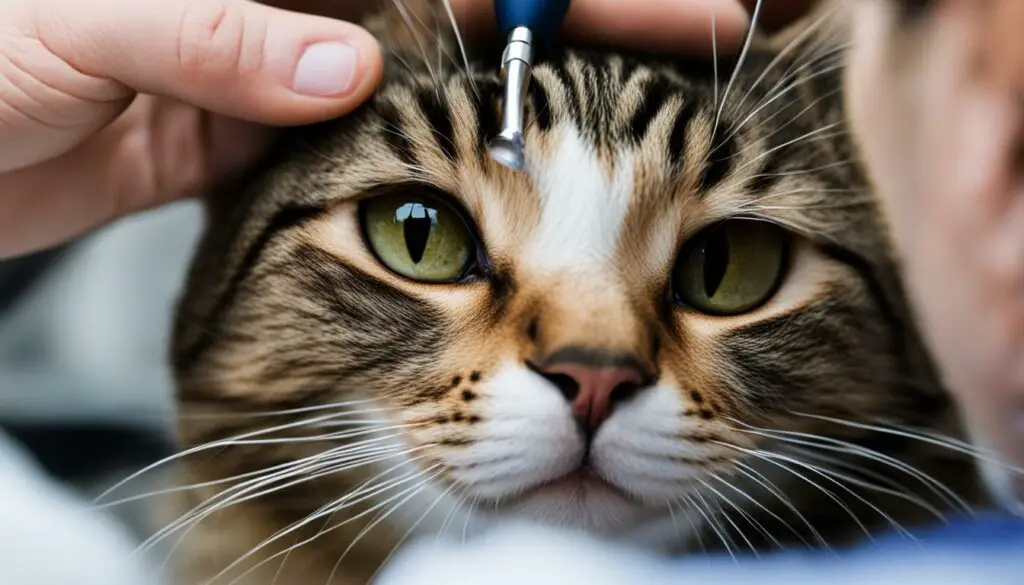
Conclusion
After exploring the various reasons why a cat may refuse to sit down all the way, it is crucial to prioritize their health and well-being. By identifying the underlying causes and seeking veterinary advice, you can ensure that your furry friend receives the proper care and treatment.
Whether it’s arthritis, injuries, constipation, allergies, or stress, addressing these issues promptly is essential. Working closely with a veterinarian, you can develop a treatment plan that may include pain medication, nutritional supplements, or lifestyle changes to alleviate discomfort and improve your cat’s quality of life.
Remember, as a cat owner, it is your responsibility to observe your pet’s behavior and promptly address any signs of discomfort or abnormal sitting postures. Regularly monitoring their well-being and providing preventive care, such as balanced nutrition and a stress-free environment, can go a long way in ensuring their overall health.
By taking these steps, you can help your cat lead a happy and healthy life, free from sitting issues and other potential health problems. Your dedication and care will undoubtedly make a significant difference in their comfort and well-being.
FAQ
Why won’t my cat sit down all the way?
There could be various reasons for this behavior, such as arthritis, injuries, constipation, allergies, or stress.
How can arthritis affect a cat’s sitting posture?
Arthritis can cause pain and difficulty in movements, including sitting and jumping.
What injuries can impact a cat’s sitting posture?
Falls or fights with other cats can result in injuries that affect a cat’s ability to sit comfortably.
Can constipation cause a cat to have difficulty sitting down?
Yes, constipation can cause pain in the rectum area and make it uncomfortable for a cat to sit properly.
What effect do allergies have on a cat’s sitting posture?
Allergies can cause swelling in a cat’s body, including the rear area, making it uncomfortable for them to sit down properly.
Can stress alter a cat’s sitting posture?
Yes, stress can lead to changes in a cat’s behavior, including an altered sitting posture.
How can I make my cat sit down?
Training and providing a stress-free environment with engaging playtime can encourage your cat to sit down.
Why is proper diagnosis and treatment important for a cat’s sitting issues?
Identifying the underlying causes of sitting issues is crucial for addressing the problem and ensuring your cat’s well-being.
How can I prevent sitting issues and maintain a healthy cat?
Regular veterinary check-ups, a balanced diet, a safe indoor environment, and minimizing stressors are essential for maintaining a healthy cat.
What is the role of cat owners in ensuring their cat’s comfort and health?
Cat owners should be attentive to their cat’s behavior, provide necessary veterinary care, and follow recommended treatment plans to ensure their cat’s comfort and health.
Why is monitoring and assessing a cat’s well-being important?
Regularly monitoring and assessing a cat’s well-being allows for early detection of potential health issues and ensures the necessary care and treatment for their quality of life.

